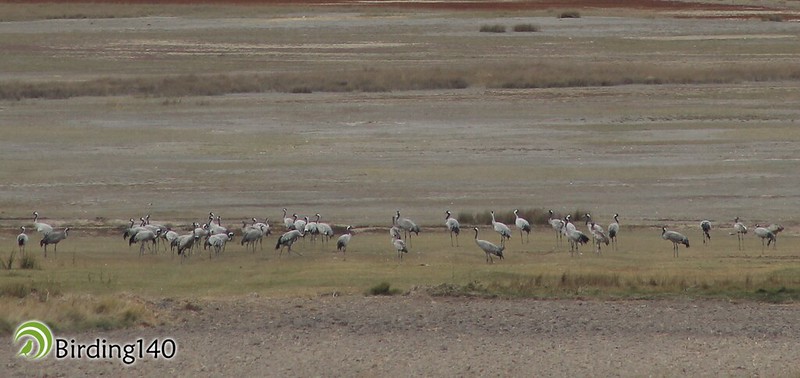Today we want to talk about an important project named Grullas vuelan sobre Huesca 2015 (cranes fly over Huesca 2015). It is carried out by Grupo Ornitológico Oscense (ornithological group from Huesca), a Spanish association devoted to the observation, study and welfare of wild birds.
The spot or spots where the large flocks of Common Cranes (Grus grus) cross the Pyrenees on their way towards the north of Europe is one of the great mysteries of their prenuptial migration through the western route.
The Pyrenees mountain range is a big obstacle for the cranes, both when they migrate towards the south at the end of autumn and when they do it towards the north at the end of winter. Most ornithologists believe that cranes don’t overcome the great heights of the Pyrenees at the same spots when they migrate towards the south and towards the north.
The southbound migration is carried out at a slower pace: the cranes are accompanied by the chicks born that year, and they stop more often along the way. The great flocks seem to overcome the Pyrenees on the most western side, the Navarre Pyrenees, where the heights are smaller. However, when cranes return to the north, they seem to use a slightly further east route, through the Aragonese Pyrenees, with noticeable bigger heights.
The arrival of the cranes to the Iberian Peninsula is one of the great sights the European nature has to offer, but the departure is even more spectacular, given that the great flocks usually start their migration by surprise. At first, small flocks start migrating northwards in a staggered way, as it if were the autumn migration; however, most of the cranes remain in the southwest of the Peninsula.
There comes a morning when dozens of thousands of cranes decide to take flight almost simultaneously and, in a few hours, in a single day, entire regions become empty of cranes. Enormous flocks fly northwards through the centre of the Peninsula.
Initially, cranes don’t leave the Iberian Peninsula: they just concentrate in the northern regions. There is something holding them. The great difficulty of overcoming the Pyrenees forces them to rest and wait for a day with proper climatology in order to face the challenge.
The lake of Gallocanta and La Sotonera reservoir are two extremely important places for the cranes in their challenge of successfully overcoming the Pyrenees. If the climatology is good, a large number of cranes spending the winter in the Iberian Peninsula will take the leap to France from Gallocanta, located about 200 kilometres from the first peaks. With an adverse climatology, however, they will choose to face the challenge from La Sotonera at the foot of the mountain range.
Grupo Ornitológico Oscense has been carrying out registers in La Sotonera and collecting reports of crane migratory passages in the province of Huesca for years. But there are still unanswered questions nowadays about the spots where the great flocks cross the Pyrenees towards the north, and about the use cranes make of La Sotonera.
To answer these questions and get a better knowledge of the migratory behaviour of the cranes, the volunteers from Grupo Ornitológico Oscense will carry out the following activities during the next days, as a part of the project Grullas vuelan sobre Huesca 2015:
-
Daily morning registers in La Sotonera from 14 February to 15 March.
-
Documentation of the migration during a whole day in three selected spots in the province of Huesca.
-
Collection of data from the whole province of Huesca in migratory file cards.
-
Documentation of the climatology at meteorology stations.
We believe that the project Grullas vuelan sobre Huesca 2015 can be very important in order to know the migratory behaviour of the Common Crane, and we encourage all of you who are in Huesca between 15 February and 15 March to participate.
Many of you are already taking part in the cooperative experiment through Twitter #Birding140, sending us the crane sightings that help us prepare the periodical reports about the migratory path of the cranes through Europe. In case you tweet sightings from Huesca during the next weeks, we encourage you to also fill in the data file card of the project Grullas vuelan sobre Huesca 2015 and send it to Grupo Ornitológico Oscense. You can download the file card and get more information in the following link (only available in Spanish).












